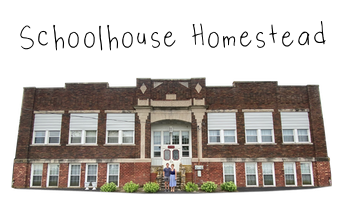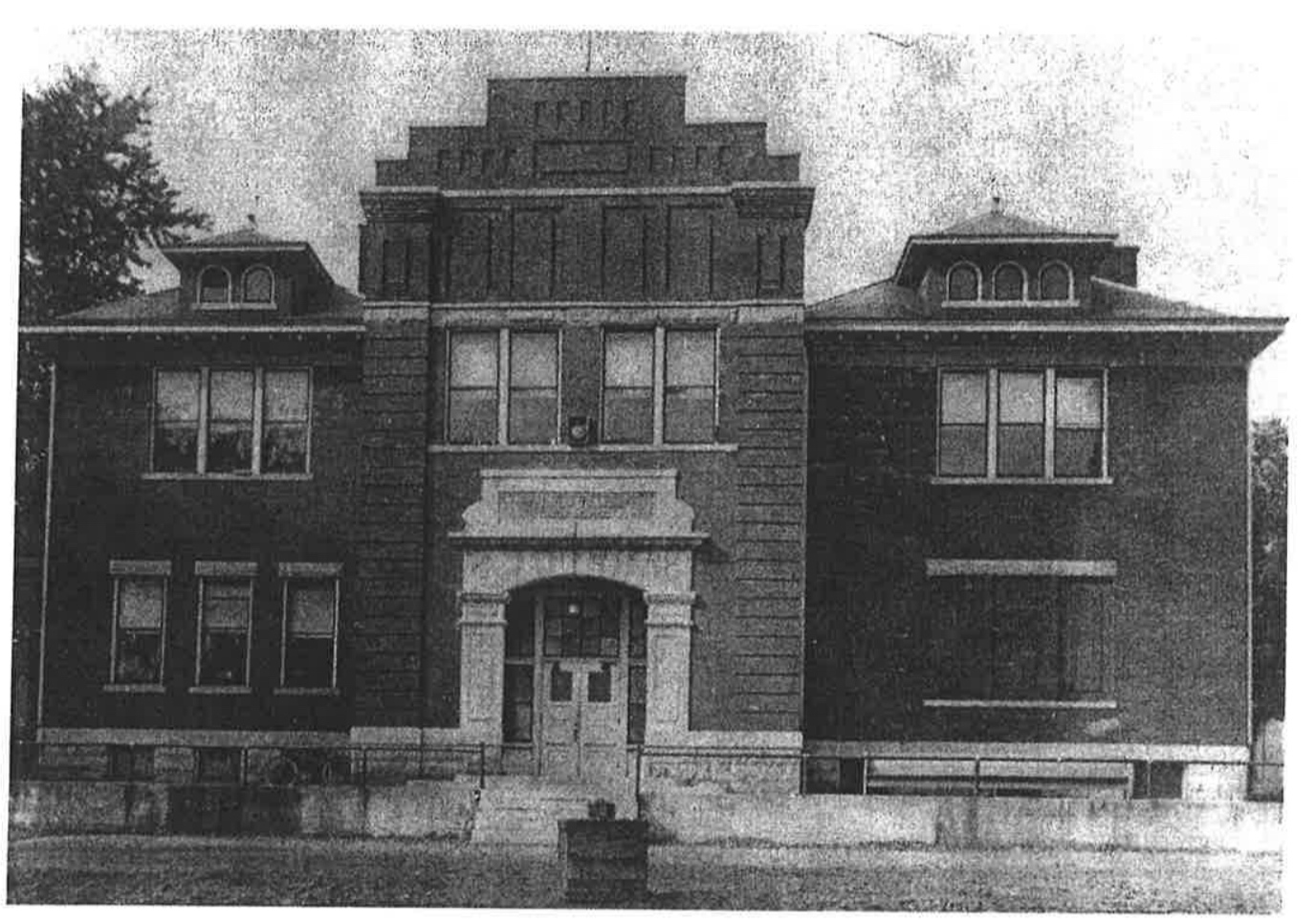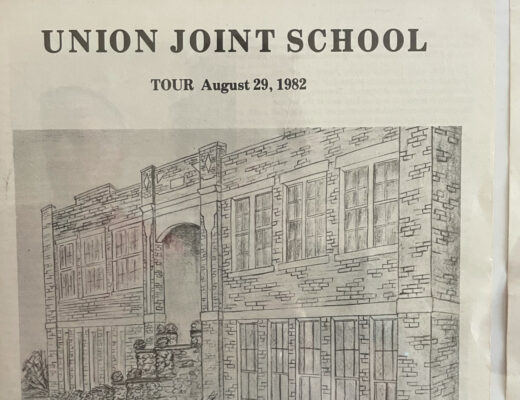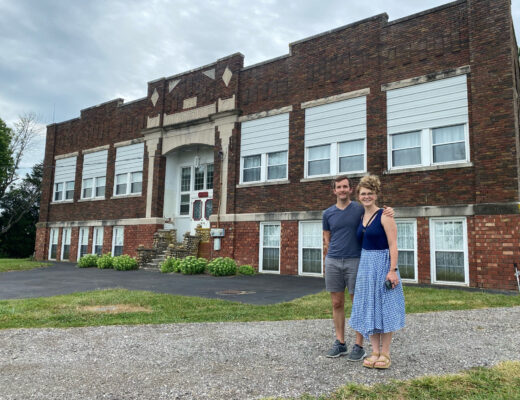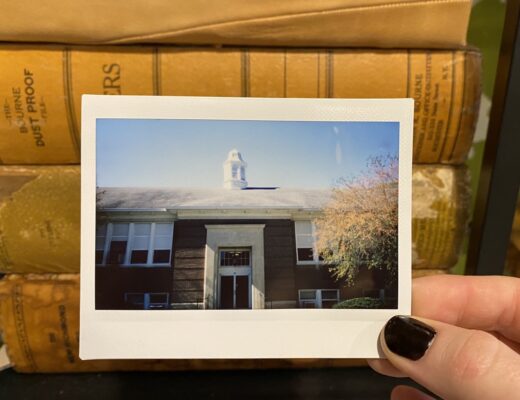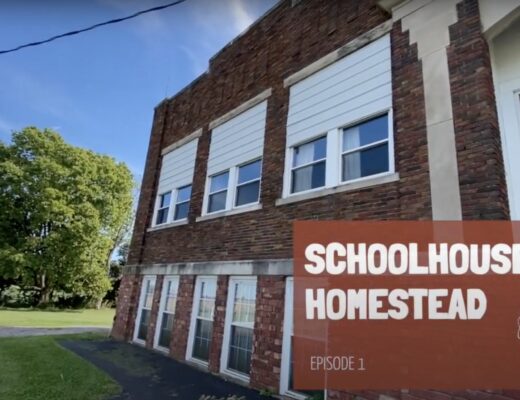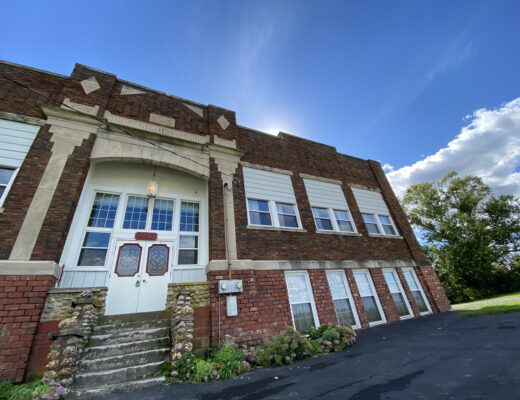When Sean and I went to the Johnson County Museum of History a few weeks back, we had the goal of finding 1) as much information about Union Joint as possible and 2) find any history of other schools in the county so that we could use them as inspiration. As two Hopewell Elementary alums, and as someone who grew up in Hopewell Church, we were also super curious about anything we could find on Hopewell.
We found this incredible essay by Charles Van Nuys and I reached out to his son, Rev. Dr. John Van Nuys, to see if I could publish his dad’s essay here. (He said yes!)
I also included a few photos of the old Hopewell Academy, the school that predates the Hopewell Elementary built in 1936 that we attended. Some of the photos are from the museum, others are from The Hopewell Journey by Kathleen Van Nuys. (Wife to Charles.)
We also got a tour of the 1936 Hopewell when we were home and I’m working on a post with many photos soon!
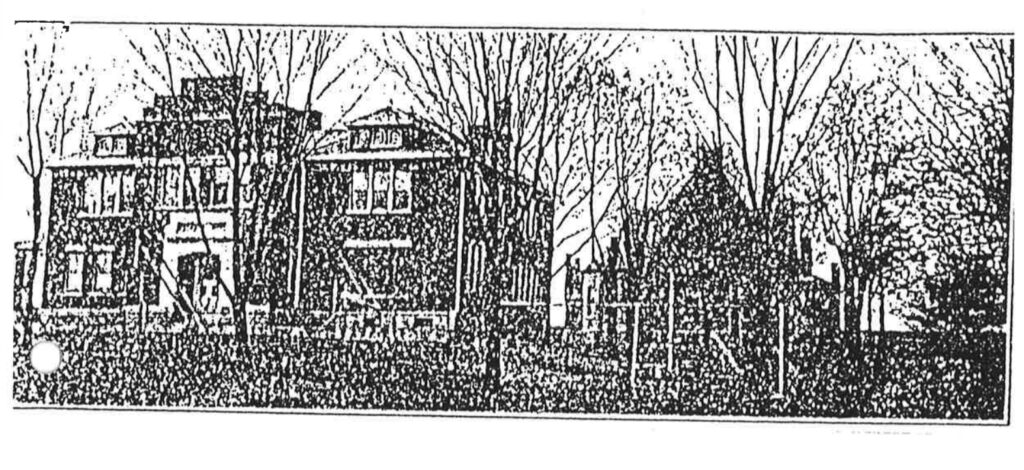
HOPEWELL SCHOOL
1923 – 1934
by
Charles B. Van Nuys
JOHNSON COUNTY MUSEUM OF HISTORY
Elementary Years (1923-30)
May 3, 1994, marks 60 years since my graduating from Hopewell High School. What wonderful memories unfold in recalling those carefree school years of the 1920s and early ’30s.
Life in Hopewell community centered around family, church and school. In fact, the huge signboard in the Hopewell Pres byterian Church manse pasture near the Franklin-Bargersville gravel roadway stated it just that way: “Hopewell, Home, Church and School.”
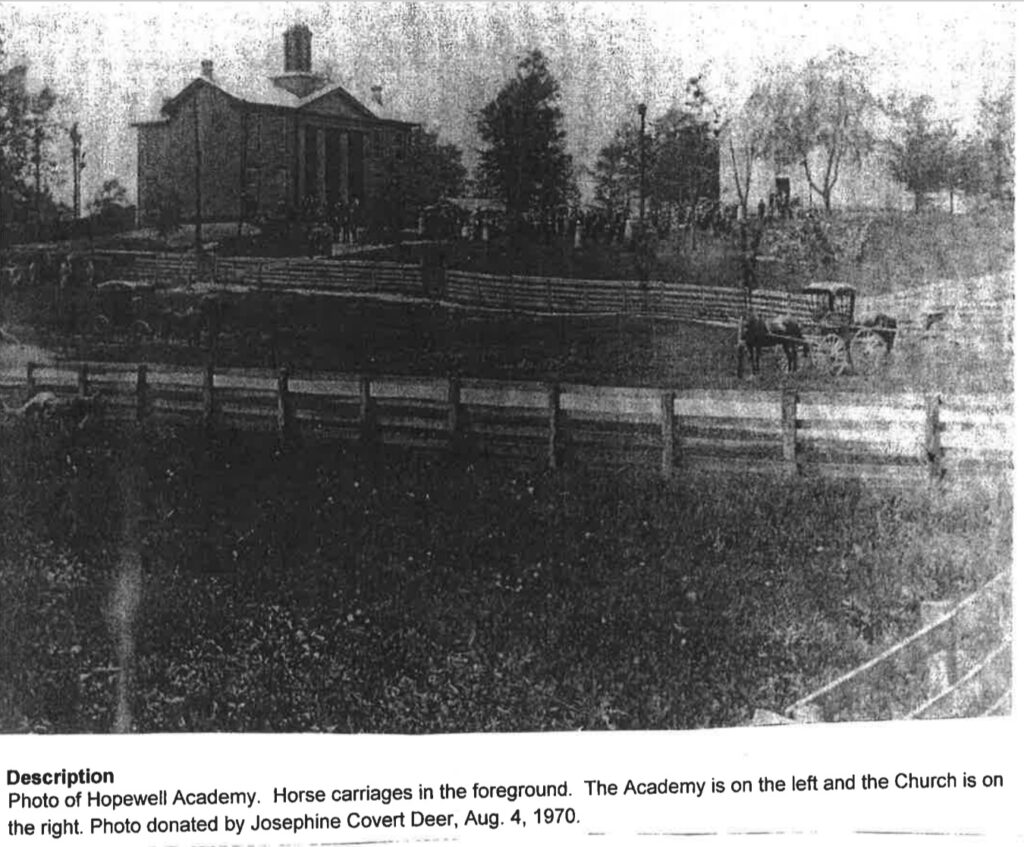
My father, Watson M. Van Nuys, took me by the hand to my first day in school, in early September, 1923. I had just turned 6 years of age on August 14 — barely old enough to be enrolled.
He had to stay with me — a tearful, bashful, scared boy — almost all day. I was not content to be left with classmates and teacher Doris Clore, who taught both first and second grades.
During that first year, I gawked at and wondered why on some Fridays a male visitor (Harold Demaree) came to sit in the back of the classroom. I was slow to realize that he was her beau and that they were destined for marriage.
The Hopewell School building — a two-story rectangular brick structure — had four classrooms on the first floor for elementary grades, one to six, and a room for the “domestic science” instruction of high school girls.
The first and second grades were together on the south side of the building. We put our coats and lunch boxes on a shelf outside the doorway.
I remember every day that the two classes would stand and sing to Miss Clore, my first-year teacher, and to Miss Frederick, the second grade teacher: “Good morning to you, good morning to you. We’re all in our places with bright shiny faces and this is our way to start a new day.”
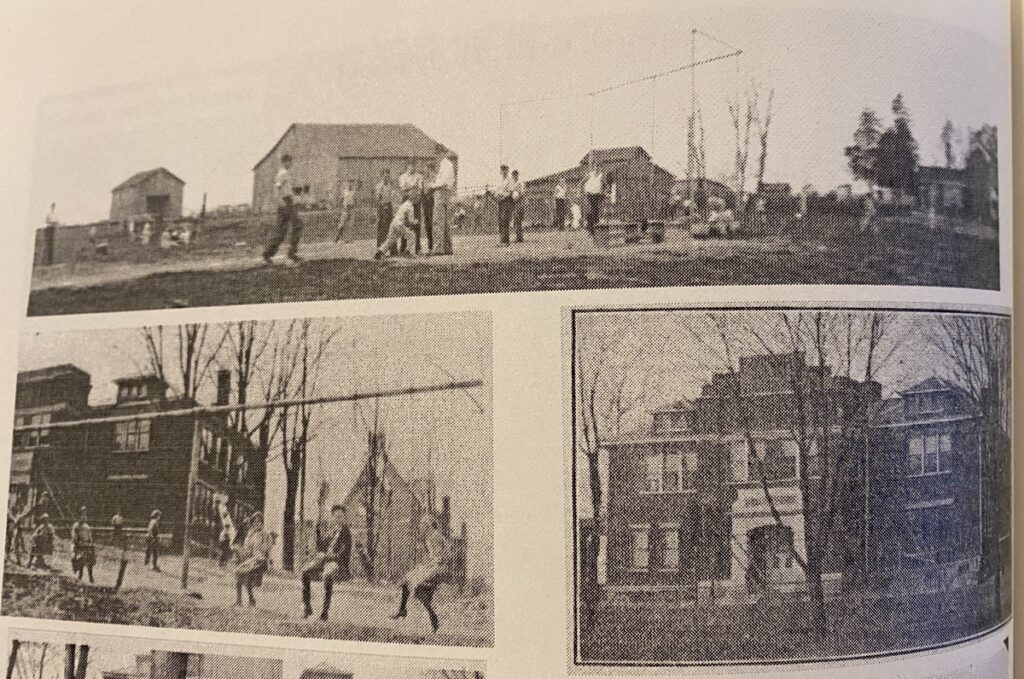
Then we said the Pledge of Allegiance to the American flag. I do not remember there ever being prayers.
My third and fourth grade teacher was Margaret Alexander. Both grades were assembled in one room on the first floor, southwest side. Actually, she had me half that time because in 1926, my family wintered in Coral Gables, Florida, and I was enrolled in school there.
Due to Florida schools having a split-year grading system, I ended up skipping a year of school. Therefore, I caught up with the classmates that I eventually graduated with from high school.
I had my first male teachers in the fifth and sixth grades, Orville Strong and Milas Drake (a hazy memory). Both had a massive physical presence and, along with Mr. Drake’s bushy moustache, dictated proper discipline and decorum.
Also teaching me at Hopewell, as my school years advanced, were Dale Jamieson and Loyd Hensley — in grades seven and eight.
Today, I treasure my early Hopewell educational years. I learned “read’n, ‘rit’n and ‘rithmetic.” I learned how to spell. Geography, American history and English grammar and composition were the epitome of the instruction.
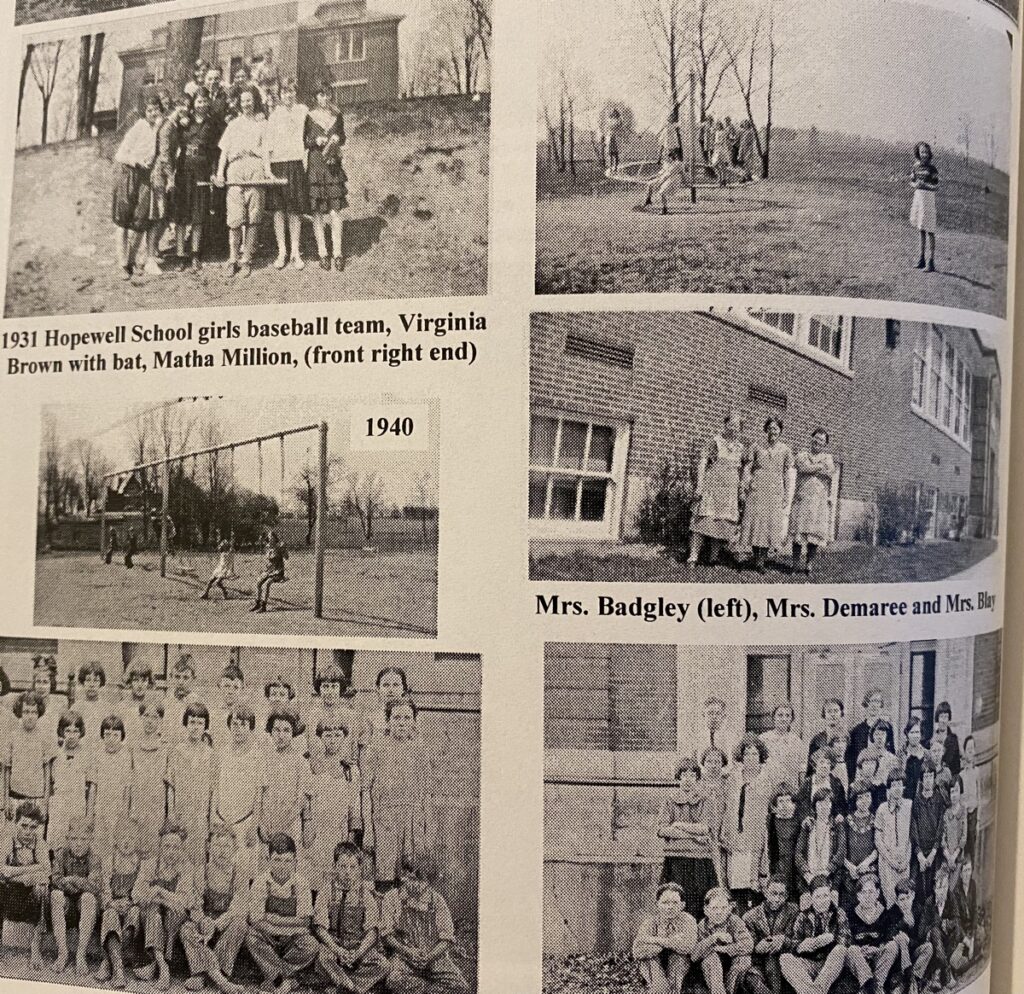
We learned multiplication tables through the number 12. There were spelling-bee contests every Friday. Teachers corrected students who verbally misused English grammar.
Each pupil was assigned to sit at a certain desk. The top raised and books and tablets were placed therein. A receptacle for ink was in the upper right hand corner of each desk.
In an early grade, Clara Margaret Ohlrogge sat in front of me. Once, her long curly hair was so enticing that I stuck several strands into my ink well.
During my elementary years, 1923 to 1930, Hopewell pupils were transported to school in “school hacks.” The vehicles were privately owned and drivers were recompensed by the Franklin Township trustee from taxes levied on property owners.
Although the hack driven by Brack Hicks passed my house every day, I walked the half mile to school carrying my black metal lunch box.
School days were from 8 o’clock to 4 o’clock. I was always on time for school because of the menacing perception I had of tardy pupils. They had to go to the “principal’s office.” I felt I didn’t need the attention of Principal Herbert Kinnear, with his piercing cross-eye and furrowed frown.
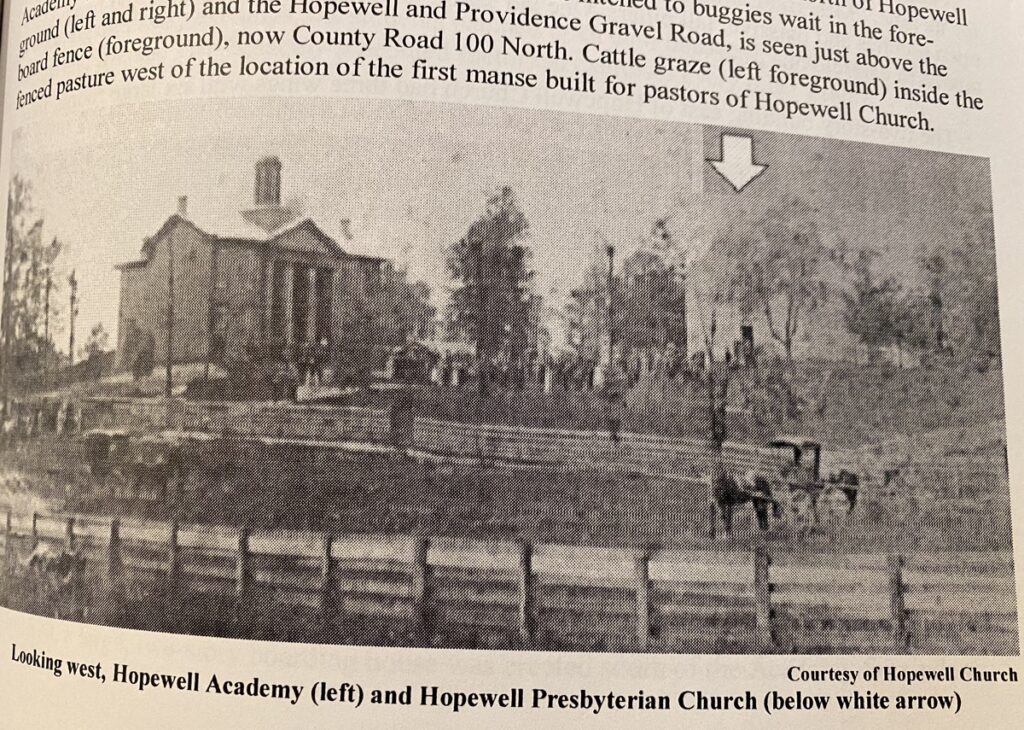
Every day, returning home was a dilatory, dallying adventure. I walked from the school yard down the slope into the Hopewell Church manse pasture, avoiding the minister’s cow, and then up the hill toward the manse.
Taking the short cut across the lawn always made for a quicker trip to the wooden structure that housed the Big Spring. It was necessary to stop at the Spring House, to lie on my belly and to sip water flowing from the spring that marks Hopewell’s pioneer beginning — 1831.
I don’t recall ever stealing sips from the crocks and jars of milk, cream and cheese that were kept cool there by the Parkhurst, Demaree and Dawson families who at one time or another lived in the Albert List house to the west.
Walking on home along the gravel road made rock-throwing a delight. I stepped aside for only an infrequent passing auto. The target (when no one could see me and report to the utility company) was glass insulators on telephone poles every 100 feet apart.
A direct hit was rewarded with a loud “pop” as the glass insulators split apart.
“Recess” was the favorite school subject.
Orderly exits from the school building were required, so only seldom was there an escape through a window to freedom.
In the school yard to the north were two metal maypole swings that had the girls’ attention, never the boys’. A teter-board was nearby. To the east of the building was a gravel-covered basketball court. Gunny sacks hung from its iron hoops.
On selected Friday afternoons, basketball games were played between Hopewell High School boys and neighboring Union and Nineveh high school teams. We grade schoolers paid scant attention because drop-the-handkerchief, blind-man’s bluff and tag were our games.
To the east of the basketball court and down the slope alongside the county road, an abandoned tennis court became a baseball diamond for spongeball athletics. (Tennis was regarded by country kids as a sissy sport).
The Hopewell Church yard and the Hopewell Cemetery, adjoining the school property on the west and south, res pectively, were held sacred and inviolate. Absolutely no one ever intruded or had thoughts of playing there.
However, it was permissible for students to play inside the church shed to the west where worshipers, prior to the 1920s, left their buggies and tethered their horses during church services. Climbing in the rafters over the horse stalls was great fun.
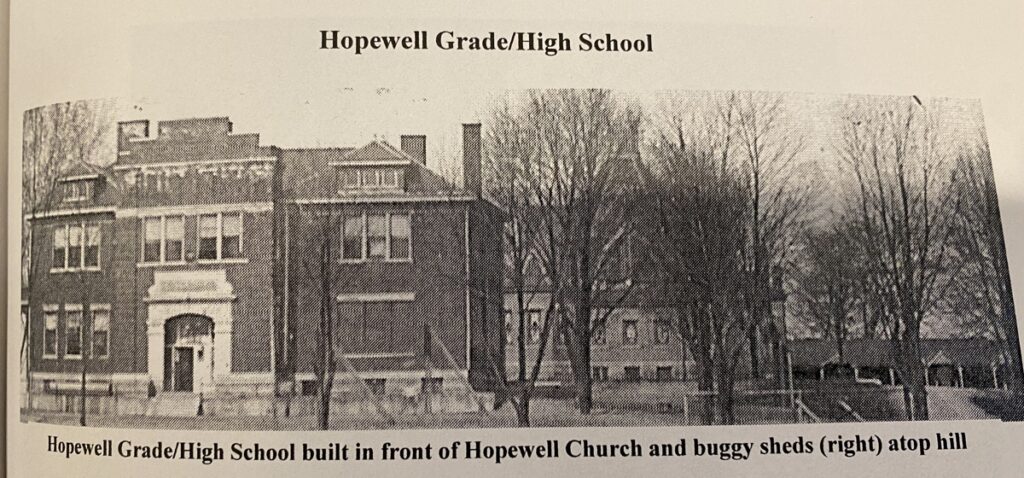
In wintertime, sledding down the steep church driveway was also fun, but one had to be wary not to slide out onto the county road.
If no teacher was watching, pupils crawled into and slid down a big metal tube — the fire escape that was installed in the northwest corner of the second-floor gymnasium.
Marble games, skipping rope, leaf fights and playing with yo-yos occasionally would be interrupted by boys and their fist-fights. Memorable are the frequent scraps between the minister’s son, Alfred Ferguson, and William Sanders (the latter chosen one year in the national 4-H competition “America’s Healthiest Boy.”)
All Hopewell pupils remember that teachers maintained strict order. That did not eliminate entirely the throwing of paper wads or the rubber-band shooting of paper missiles, or the passing of written notes. The most mischievous act one could commit was to bend a pin so as to form a tripod base and slip it onto the seat of a classmate who was at the blackboard ciphering.
Every pupil was seated unless reciting. Movement was permitted when pupils held aloft one or two fingers indicating an urgent need to go to the restroom in the basement.
Teachers were quick to correct pupils’ grammar. Spoken and written sentences were not allowed to end with a preposition. Using the word “ain’t” was absolutely forbidden. There also were no recitations or dialogue interspersed with the now familiar “you know” expression.
Hardy grade schoolers came to school barefoot on warm, late fall and early spring days. I was a tenderfoot.
Completing the eighth grade on April 25, 1930, were:
Virginia Brown, Frederick Ellett, Elsie Elnora Giddings, Mary Lois Gilmour, Lawrence Hugh Hamilton, William Arthur Mitchell, Marjorie Murray, Doris Elizabeth Niccum, Clara Margaret Ohlrogge, Emma Elizabeth Pickerell, Virginia Records, Helen Faye Smith, Charles Edward Tharp, Charles Branigin Van Nuys and Leta Louise Utterback.
We received an eighth grade “certificate of completion” at the time of high school graduation exercises that always marked the end of the eight-month school year. The ceremony at Hopewell Church attracted a capacity crowd. I got to play my cornet in the Hopewell Orchestra and move to and fro from among the musicians to be with my seated schoolmates in the converted choir area.
Hopewell High School Years (1930-34)
My high school years were the “salad days” of my youth — four wonderful years even though the Great Depression was in full, devastating force. We didn’t know that we were “poor” or “neglected” or youth fallen through the cracks of prosperity which President Herbert Hoover said was “around the corner.”
We lived happily in our little country-community world where our desires were kept within our needs. Boys and girls were considered old enough to “date” when they were in high school. Some were able to have dates with friends from other schools.
Going to Hopewell Church on Sunday nights was the usual thing to do. Adventurous couples who dared risk gossip would sneak to the Artcraft Theater in Franklin to attend a Sunday night movie.”
To splurge was to have a 10 cent chocolate soda at Woods Drug Store. The sanctity of Sunday in Johnson County was beginning to erode in the 1930s. Gradually, we didn’t have to sneak off to the Brack Hicks’ home to dance. We began to admit having decks of playing cards at home in addition to our Rook game cards.
Some people began to play pick-up baseball games on Sundays. older people even began to listen to radio accounts of the Cincinnati Reds on station WLW.
The high school curriculum was determined by state standards. My toughest and most detested course was Latin, taught by Effie Winterroud. Suffice it to say that, without a “pony,” I never would have passed the course. I was able to master easily Miss Winterroud’s courses in bookkeeping and typewriting, but disappointed her with a dismal performance in the state typing contest when my fingers failed to find home row in the accuracy contest.
Elsie Giddings put Hopewell on the map by scoring honors in the state Latin contest.
The “manual training” course under Principal Kinnear was an effort that failed to make me handy with woodworking tools.
The Depression years necessitated the use of scrap lumber from Graham Manufacturing Company in the construction of a desk. Lawrence Hamilton turned out a masterpiece, but my unit is still begging attention after 60 years.
All boys and girls were under the tutelage of Edna Johnson for music and art. It became a proven fact that Hopewell country boys had not been culturally endowed.
We studied English for four years under Principal Kinnear. The final year was a study of the Bible as literature, but it may have been more a religious than literary study. Some students memorized the book of Ruth.
The girls’ trio of Virginia Brown, Claribel Featherngill and Virginia Records received musical accolades during four years of community appearances. The girls, Elsie Allen, Elsie Giddings, Mary Lois Gilmour, Matha Million, Marjorie Murray and Doranell Ramsey, were active members of the Sunshine Society. They helped found a chapter of the Sunshine Society at Clark High School.
There was no other group activity for girls and basketball was the only organized effort for the boys. A cultural program that included all four high school classes and grades seven and eight was the assembly program on Friday mornings. The big console radio was tuned loudly to the Walter Damrosch Music Appreciation Hour — heard in school rooms throughout America at 11 a.m.
The boys in my class, Lawrence Hamilton, William Mitchell, Joseph (called Cicero) Ramsey and Charles Tharp, eagerly embraced the physical education classes and basketball coaching of Russell Green. It was great fun to have new basketballs. They were inflated by the insertion of a needle. In older balls, it was necessary to unlace leather strings to re-inflate them. The inflating needle was so treasured that today it is still stored in our Seth Thomas clock at home.
Hopewell basketball teams, first and second, which included all 18 boys enrolled in the high school, competed rigorously against other county high school teams. Our “home games” generally were on winter Friday nights at the Indiana Masonic Home school gymnasium or at the Franklin High School gym, whichever was available. We competed as sportsmen, winning some games — losing, too.
We never won a county or Indiana High School Athletic Association tourney but did win our way to the championship game of the county tourney one year. Matha Million was our team cheer leader. The beginning of the end of Hopewell High School in the Franklin Township school system resulted from a catastrophic fire that completely destroyed the building. In December, 1932.
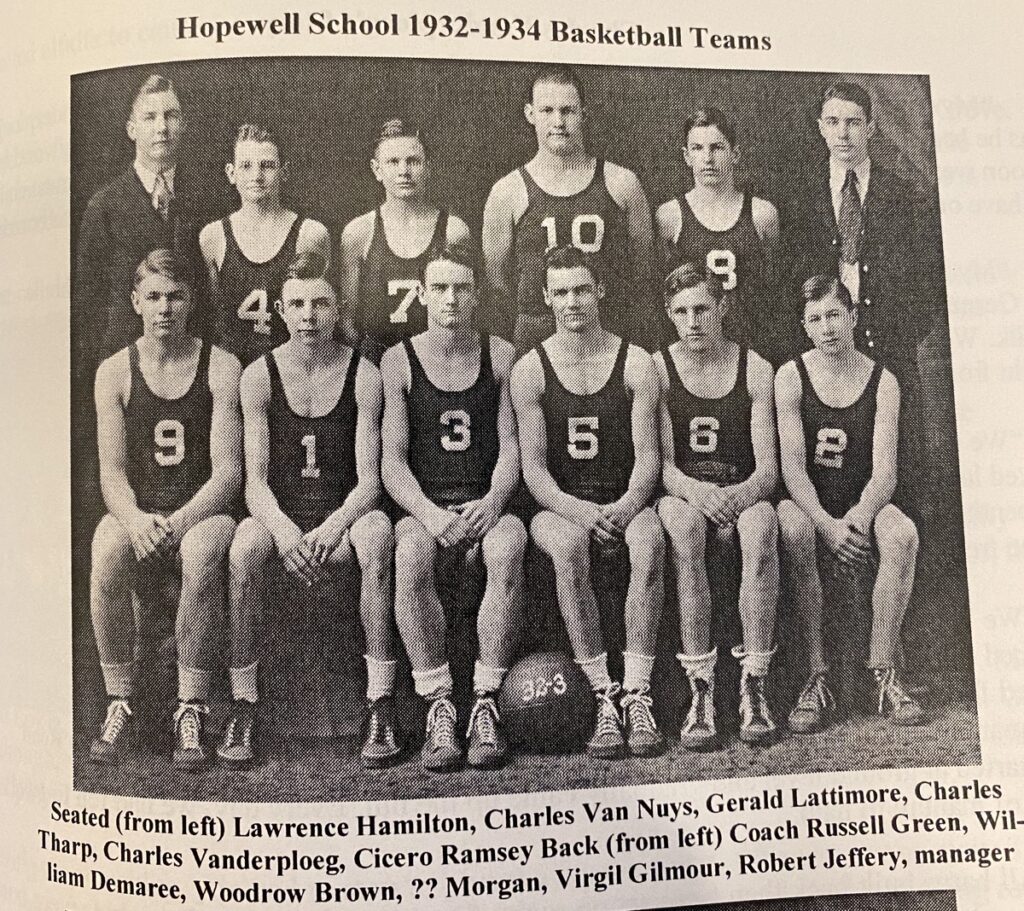
The midnight fire resulted from an over-heated boiler and the building collapsed into smouldering rubble. A contributing factor was the wooden flooring that was oiled regularly to prevent shrinkage and to keep down dust. There was no fire department to call and those present could only watch helplessly. Few people knew about the fire until the next morning.
My family was unaware of it. I was walking to school as usual with lunch bucket in hand when my Dad drove his Buick alongside me. I got in and we went to view the disastrous scene.
After Christmas vacation, Hopewell High School’ pupils were accommodated in vacant rooms at Franklin High School where I completed my school years. Elementary pupils were quartered at Union and Masonic Home schools. Students at Franklin and all county schools generously shared their books and supplies to keep Hopewell alive.
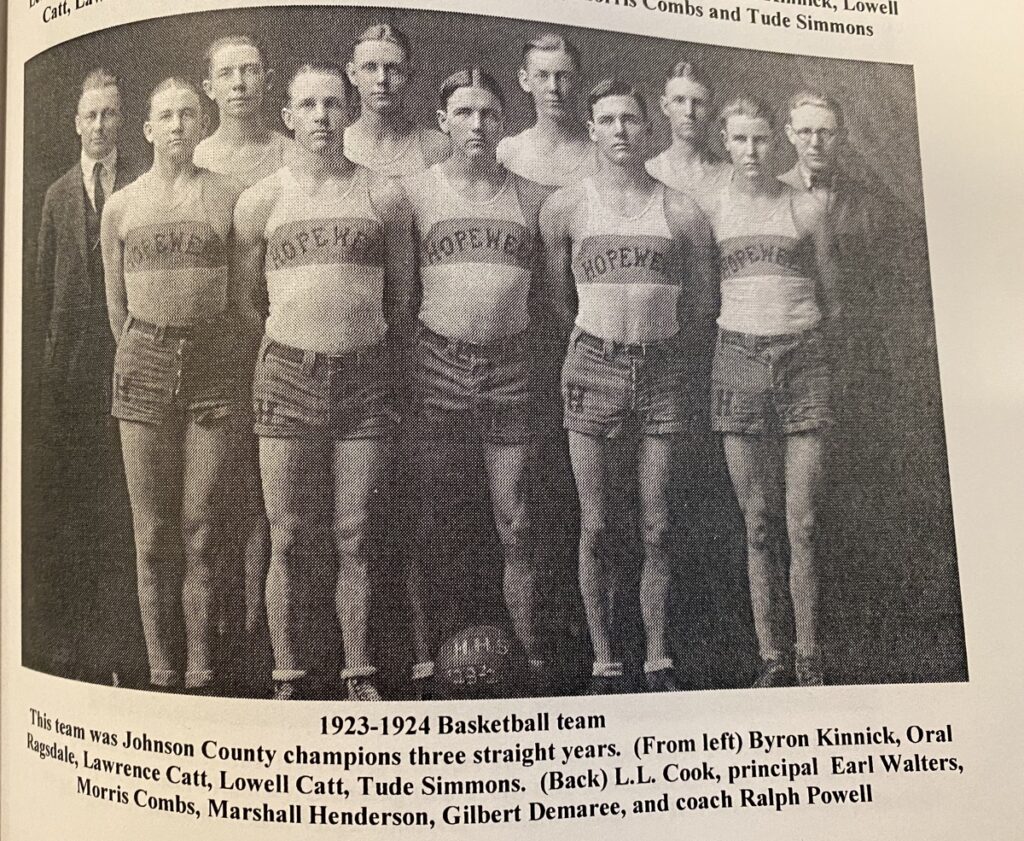
Fourteen members in the 1934 Class made it the largest to graduate from Hopewell (though study finished at Franklin). Demise of the Hopewell High School name was due to lack of younger students and mounting pressure for school consolidation.
The last class, five members, graduated May 2, 1935.
The present Hopewell School, occupied in the fall of 1936, offered instruction through nine grades until the fall of 1938 when all high school pupils enrolled in other county schools.
Recalling our social get-togethers during my high school years brings to mind the fun of New Year’s Eve watch parties at Virginia Brown’s home. Before the midnight hour, we played “Cootie” — an innocuous dice game.
Preparation was lengthy for the Junior-Senior Reception (not called “prom” then). During our last two years, we spent weeks planning and days decorating the Red Elephant Inn in Franklin for the event.
The 1934 Senior Class play, “Tea Topper Inn,” was presented on the stage at Franklin College. Of course, families and community friends came, resulting in a capacity crowd. I remember it was difficult for me to memorize so many lines.
Hard times during the Depression caused ebbs and flows in school attendance. Some students were out for days at a time working on the farm or otherwise helping their families. Still others moved away, transferring to different schools.
However, arriving at Hopewell for portions of my high school years were Edna Morris and Martha Traub. Fortunately, most of the beginning freshmen became fellow graduates on May 3, 1934. Hopewell Church was filled to overflowing then and the previous Sunday night for baccalaureate with Rev. John B. Ferguson, former Hopewell minister, speaking.
Noted Indiana lawyer-orator Albert Stump delivered the graduation address following an invocation by Rev. Malcolm McNeal, the church minister.
The Will Records-directed Hopewell Orchestra performed in annual graduation custom. I’ve always bragged that I was “paid to graduate” since I received $5 to play my cornet.
We blue-robed 14 graduates were seated behind the pulpit for the 46th such event. Each wore a lily of the valley, our class flower, and thought of our “stimulating” class motto: “Out of school life into life’s school.”
Graduation was a glorious time. I remember it vividly. Surely, all high school graduates cherish GRADUATING.
Members of the 1934 Class assembled at its 60th year reunion at Hopewell Church this June 11, 1994 are:
Elsie Allen McCoy
Virginia Brown Pierce
Claribel Featherngill Dick
Elsie Giddings Helman
Matha Million Taylor
Marjorie Murray Beard
Joseph C. Ramsey
Charles B. Van Nuys
Who remember with fondness our deceased fellow graduates:
Mary Lois Gilmour Steelman
Lawrence H. Hamilton
William A. Mitchell
Doranell RamseyJackson
Virginia Records
Charles E. Tharp
May they rest in Heavenly Peace.
